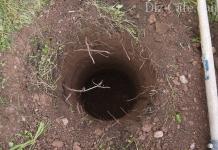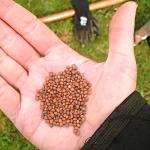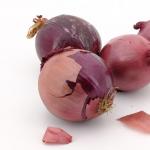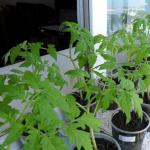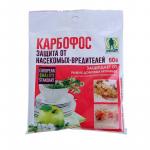Radish is a healthy root vegetable from the cruciferous family of annual plants. It is often grown in summer cottages, as it prefers a temperate climate and weather conditions accessible to many regions. The history of radish cultivation goes back to antiquity. He recommends that every summer resident plant radish on his plot and eat it, then for food, since this vegetable is a storehouse of useful vitamins and microelements.
How and when to plant radishes in open ground, how to properly fertilize them, how to treat the soil so that it is not affected by diseases, and how to store vegetables, you will learn in articles devoted to caring for radishes in open ground.
When to plant radishes in open ground
Radish is a cold-resistant plant - its seeds germinate without problems at temperatures of +3–5 °C, and seedlings can tolerate temperatures dropping to +3–4 °C. Temperature changes that often occur in the spring are also not scary for root crops. Frosts from -5 to warming to above-zero temperatures are perceived by the vegetable with resistance. Therefore, to the question “when to plant radishes in open ground” the answer is clear: as soon as the snow melts and the soil warms up to the above temperature. The best option when you can plant radishes in open ground is from April 25 to May 10.
It is recommended to sow seeds of summer varieties in the spring, from late April to late May. Early varieties are more resistant to cold, so they can be sown in the last ten days of April. Medium-ripening varieties are sown in May. The most comfortable temperature for growing radish is considered to be +18–20 °C. It is desirable that such a degree be established approximately 1–1.5 weeks after emergence. Based on this information, it is easier to calculate the most successful planting dates. 
Winter radishes are grown for autumn and winter consumption. The optimal time period for sowing it is considered to be from mid-June to mid-July, but it is necessary to take into account the characteristics of each variety. The average ripening time for winter root crops is 100-110 days. Knowing the climate of your region, it will not be difficult to calculate the most appropriate time for sowing winter crops. To determine the planting date more accurately, gardeners use the lunar calendar - radishes planted during the waning Moon grow faster and better.
Soil for radishes
It places great demands on soil quality. The soil should be fertile, loamy, moist and rich in humus. In the fall, after harvesting the previous crop, loosen the soil in the area reserved for radish to a depth of 5-7 cm. After 2 weeks, dig deep to 25 cm, at the same time apply fertilizers per 1 square meter. m: 3-4 kg. humus or compost, 25-35 g of ammonium nitrate and potassium salt, 35-40 g of superphosphate. Remember that fresh organic fertilizers cannot be applied to all cruciferous crops. They should be rotted or plant root crops in areas where fresh fertilizers were applied 2-3 years ago.
In the case where flowering plants such as cabbage, radishes, rutabaga and turnips previously grew on the selected soil, then it is better not to grow on it. If other crops grew there previously, then radishes can be planted.
How to plant radishes in open ground
Planting is carried out in two terms. If it is desirable to obtain the harvest in the summer-autumn period, then the seeds should be planted starting from the 25th of April. If winter storage of the crop is planned, then the seeds are planted from June 20 to July 10. Planting dates also depend on the variety. When planted early, the roots of winter varieties crack. And the release of inflorescences in this case begins in the first year. 
Furrows are made in the prepared bed. They are made at a distance of 30 cm. Their depth is 1.5 - 2 cm. Seeds are placed in the furrows in 3 nests. In this case, the distance between these nests should be at least 15 cm. The soil should be sufficiently moist. If there is insufficient moisture during planting, then after planting it is necessary to water it. The beds are sprinkled with mulch (compost, humus) to maintain moist soil. After 5 or 6 days, the strongest shoot is left in each nest. Both young shoots and adult plants can withstand light frosts. Up to - 5 °C.
Tips for planting and growing radishes in open ground
- Precursors such as potatoes, tomatoes, carrots, cucumbers, and beans will help you get a rich harvest.
- To ensure large and regular shaped fruits, you need to maintain an optimal level of seed sowing frequency. If you plant a vegetable too densely, then, most likely, a flower arrow will appear and the root crops will be small.
- The risk of improper plant development will also increase if you plant seeds ahead of schedule.
- Delay in sowing time will also be detrimental to the harvest. When frost sets in, root vegetables lose their beneficial properties, and the flesh of the plant becomes woody.
- If there is a wireworm in the garden, then you need to collect the fruits of the plant for the winter immediately after the potatoes, so that the pest does not spoil the harvest.
- The secret to tasty, round and juicy root vegetables lies in rocking the plants during active growth. This event will help remove the side roots, so that the root crop will be fed from the central root. This is the method that many summer residents use when growing radishes.
Caring for radishes in open ground
Radish is an unpretentious plant that does not require special care. Therefore, growing radishes in your own garden will not require much labor or physical effort from you. It will be necessary to water the individuals, thin out their thickets, loosen the soil and eliminate all weeds, as well as fertilize the plants with special fertilizers.
Caring for radishes also includes thinning. It is first carried out after the formation of a pair of leaves in young shoots. In this case, it is worth leaving a distance of 0.06–0.07 meters between root crops. The next time thickening is warned after a month. 
When growing root crops in unprotected soil, weeding between rows is carried out three to four times per season. For the first time they loosen to a depth of 0.04 meters, the second time - to 0.08 meters, subsequent times - to 0.1–0.12 meters.
Experienced gardeners recommend feeding radish plantings at two main times. The first time this is done after the crops have formed their first true leaves. During this period, it is necessary to prepare liquid fertilizer based on superphosphate - 50-60 grams, potassium chloride - 12-15 grams and urea - no more than 20 grams. All of these elements are dissolved in a bucket of water, and then the plants are watered. 
You can feed radishes with dry granular fertilizers, but their amount is reduced by three times. In terms of per square meter of usable area, it is necessary to add 10 grams of urea, 20 grams of superphosphate and 5 grams of potassium chloride. These components are scattered on the surface of the earth between the crops, and then the rows are loosened and watered.
Black winter radish is a round root crop with a diameter of 8-12 cm, with thin black skin and white, soft, tender and very juicy pulp. The weight of one unit can reach 500 g. But many gardeners like fruits weighing 250-300 g, and that’s what they grow. This variety has good taste and differs from others in its excellent keeping quality (it is stored well and for quite a long time).
Black round radish is especially suitable for use in winter and spring to enrich the diet with vitamins and minerals. The vegetable is consumed raw and processed. According to folk recipes, it is used to prevent and treat colds, it will help with urolithiasis, for a choleretic effect, accelerates the healing of purulent wounds, and treats cough.
Radish is contraindicated for peptic ulcers, inflammation of the gastrointestinal tract and liver, and heart disease. Before using it, consult your doctor!
Planting rules: choosing a place, time, taking into account crop rotation, soil preparation
Radish is an unpretentious vegetable to grow and is not particularly demanding on the composition of the soil. Fertile neutral or slightly acidic soil, the layers of which are deeply cultivated, is suitable for growing radish.
Winter round black radish
Radish does not like shade, choose a well-lit part of the garden. You can sow it in place of harvested early crops. When choosing a place to plant radishes, take into account crop rotation, or rather, predecessors. You will get a good harvest if you plant winter radish in the place where potatoes, beans, tomatoes, cucumbers, and carrots previously grew. It is not recommended to choose a place after cruciferous vegetables (turnips, radishes, rutabaga). After all, they have the same pests as radishes, for example, the cruciferous flea beetle, the larvae of which can survive in the soil and then infect new plants.
Threat to radish: cabbage leaf beetle, cabbage aphid, flea beetle, cabbage fly, slugs, rapeseed flower beetle.
And here is how black radish is planted in all details, indicated
If it turns out that crop rotation was not taken into account and the root crop was planted in an unfavorable place, then be prepared to treat the seedlings with insecticides. They practice sowing radishes between rows of potatoes or onions, as well as between cucumber bushes.
You may also be interested in information about how
The video shows a description of the radish variety6
Sowing and care
 Seeds are sown in furrows, maintaining a distance between rows of 30-40 cm, per 1 m there should be a consumption of 0.5 g of seeds, a sufficient depth of 1-2 cm. When sowing, the soil should be moist, so it is not recommended to use it, since the seeds are planted after rain or additionally water the ground. You also need to provide moist soil until the seeds sprout; it is worth watering in the future at least once a week.
Seeds are sown in furrows, maintaining a distance between rows of 30-40 cm, per 1 m there should be a consumption of 0.5 g of seeds, a sufficient depth of 1-2 cm. When sowing, the soil should be moist, so it is not recommended to use it, since the seeds are planted after rain or additionally water the ground. You also need to provide moist soil until the seeds sprout; it is worth watering in the future at least once a week.
When the radish sprouts and 2-3 leaves appear, the seedlings are thinned out. After three weeks, it’s worth thinning them out again so that there is a distance of 12-15 cm between the plants. Then the fruits will grow large and regular in shape. When they grow denser, the roots will be small, or, worse, the plant will go into a flower shoot. If it is present, the root crop does not form, so the arrows must be removed immediately during thinning. The rows are weeded and loosened. Remember about feeding.
But when to plant Margelan radish in the Urals, and what you should pay attention to when planting, it is indicated
An excellent fertilizer for radish has the following composition:
- urea – 20 g; Here's how it's used
- superphosphate – 60 g;
- potassium chloride – 15 g;
- water – 10 l.
It is enough to feed the root crops twice: when the seedlings have 3-4 leaves, and the second time – a month after the first feeding.
It is important to ensure regular watering; radish is a moisture-loving crop and in a drought you should not hope for a good harvest.
 It happens that good root crops are stored for storage, but after some time brown areas form inside them. This means that the radish was affected by an infection - vascular bacteriosis. The disease spreads in warm, moist environments and is transmitted by seeds.
It happens that good root crops are stored for storage, but after some time brown areas form inside them. This means that the radish was affected by an infection - vascular bacteriosis. The disease spreads in warm, moist environments and is transmitted by seeds.
Therefore, before sowing, preventive measures should be taken: warm the seeds in the sun. Recommended temperature – 45C, warming time – 30 minutes. It is also important to adhere to proper crop rotation.
To increase the juiciness of the radish, the root crops are slightly rocked during growth. In this case, the roots extending to the sides are cut off, but the central tap root is preserved, through which the vegetable feeds.
It will also be useful to know what types of
Radish is the most unpretentious vegetable crop. Many gardeners grow it on their plots, as the vegetable has not only an excellent, slightly pungent taste, but also healing properties. Our ancestors also used root vegetables to treat diseases, strengthen the immune system, and even now it can be found in some herbal preparations. Growing radishes in the garden is a simple and not troublesome process, and the benefits of the vegetable are invaluable. This article will tell you when to plant radishes in open ground and how to do it correctly.
Radish is a cold-resistant plant - its seeds germinate without problems at temperatures of +3–5 °C, and seedlings are able to withstand temperatures dropping to +3–4 °C, and even short-term night frosts, which often occur in the spring. Therefore, to the question “when to plant radishes in open ground” the answer is clear: as soon as the snow melts and the soil warms up to the above temperature.
It is recommended to sow seeds of summer varieties in the spring, from late April to late May. Early varieties are more resistant to cold, so they can be sown in the last ten days of April. Medium-ripening varieties are sown in May. The most comfortable temperature for growing radish is considered to be +18–20 °C. It is desirable that such a degree be established approximately 1–1.5 weeks after emergence. Based on this information, it is easier to calculate the most successful planting dates.
Winter radishes are grown for autumn and winter consumption. The optimal time period for sowing it is considered to be from mid-June to mid-July, but it is necessary to take into account the characteristics of each variety. The average ripening time for winter root crops is 100-110 days. Knowing the climate of your region, it will not be difficult to calculate the most appropriate time for sowing winter crops. To determine the planting date more accurately, gardeners use the lunar calendar - radishes planted during the waning Moon grow faster and better.
The soil
Radish is not very demanding on the soil, but the yield and taste of root crops largely depends on its composition. The best soil for radish is fertile loam, rich in humus and humus, or sandy loam soil. For successful growth, root crops need constant but moderate humidity, as well as neutral or slightly alkaline acidity of the soil. If the soil on your site is acidic, then it needs to be limed.
Radish is grown from seeds that are sown in pre-prepared soil. Since it is customary to plant summer radishes very early, the beds are prepared in the fall. The area is dug up to a depth of 15–20 cm, all excess debris (roots, weeds, stones, clods) is removed, organic fertilizers are added at the rate of 1 bucket of compost or humus and 1 glass of ash for every 1 m². Fertilizers are mixed with the soil, the area is leveled and left until spring.
If the radish is supposed to be planted in an area where organic fertilizers were applied last year or 2 years ago, then you just need to dig up the soil and add a little mineral mixture (30–40 g of superphosphate, 25–30 g of nitrate) - there is no need to add any more organic matter. It is advisable to pay attention to the predecessors and neighbors of the radish. It should not be sown after any cruciferous crops, horseradish, or carrots.
Beans, tomatoes, cucumbers, zucchini, and corn are considered successful predecessors for the crop. Peas planted nearby, as well as any pumpkin crops, have a beneficial effect on radishes.
How to plant in open ground
Before planting seeds in the ground, they need to be calibrated and prepared. For planting, the largest (2 mm) specimens are selected and soaked for a day in a solution of potassium permanganate or saline solution (50 g/1 liter of water). Then they are laid out on cloth or paper, slightly dried, after which they can be sown in the ground.
The bed prepared in advance is slightly loosened and furrows 2–3 cm deep are made at a distance of 25–30 cm. If the variety is small-fruited, or the root crops go deep, like daikon, then a smaller distance between rows is acceptable - 15–20 cm. Then the seeds are laid out in nests in the rows 3-4 pieces at a distance of 8-10 cm, after which the furrows are covered with earth. If the soil was not moistened before planting, the rows must be watered.
Some gardeners plant radishes in single nests along the edges of the beds or between cucumbers and pumpkins until they spread out - this planting option is also possible. In about a week the first shoots will appear. When the sprouts form two true leaves, the nests are thinned out, leaving one of the strongest sprouts. The soil between the rows is loosened and weeded, and the row is lightly hilled.
Planting winter varieties
Growing winter radishes is a great opportunity to consume this wonderful product throughout the winter. Mature root crops normally tolerate frost on the surface and sub-zero temperatures down to -5–6 °C. This resistance of the crop to cold allows you to harvest a late harvest, and thereby prolong its storage. In addition, winter varieties have many advantages over summer radishes - they are less susceptible to damage and rot, winter root vegetables are more medicinal, and are also quite large in size (300–600 g).
Winter varieties of radish should be sown using the same technology as summer varieties, however, there are some features that determine the yield and size of root crops:
- the area for winter radish needs to be prepared in the spring;
- the distance between nests with seeds should be increased to 15–20 cm, taking into account the size of the root crops.
It has already been said about when to sow winter varieties, but it should be noted that these are average dates that may vary depending on the climate and varietal characteristics.
In temperate and southern climates, it is better to plant seeds from mid-July, since winter in these regions comes later, and the plants can have time to sprout. Where summers are not hot and frosts come earlier, you can sow in the second half of June. For early-ripening varieties, the optimal time will be the beginning of August, but you should not sow later than this date, since the root crops will not have time to ripen and gain the required weight.
Winter varieties are less demanding to care for. They do not need abundant watering - during the season it is enough to moisten the bed 3-4 times, and only if there is no rain. Harmful insects, as a rule, are no longer active at this time, so there is no need to treat the plants. Winter radishes are fed with small doses of mineral fertilizers, but feeding should be stopped after 3-4 weeks. To avoid the accumulation of nitrates, you can use dust or ash solution. Winter radish produces high yields - if from a summer garden bed it is possible to collect 20–30 kg per 10 square meters of area, then when growing winter varieties, the yield increases to 40–60 kg per 10 square meters of bed.
Video “Sowing radishes in the ground”
From this video you will learn how to sow root seeds in open ground correctly and in what time frame.
The lunar sowing calendar for gardeners and gardeners for July 2017 will be able to assist you in planning work in the garden and vegetable garden and will be able to help you determine favorable and unfavorable days of the month for planting and caring for plants. It contains recommendations for planting a particular plant. It is worth focusing not only on the lunar sowing calendar for July 2017, but also on climatic conditions. Particular attention should be paid to the periods of the waxing and waning Moon. Plants should be planted on the waxing Moon, then the harvest will be good and will not cause any trouble. But it is better to carry out picking and a number of other garden activities on the waning moon.
|
date |
Moon in Zodiac signs |
|
|
First Quarter Moon in Libra |
· Scales · In the garden- planting potatoes for the second harvest, sowing leaf mustard, late-ripening spinach, celery and parsley - for forcing greens in winter. Planting seeds, fertilizing vegetable plants, watering, pinching. · Flower garden— planting and replanting roses, tuberous and climbing flowers, rooting cuttings, mineral fertilizing, watering, loosening. · In the garden- a good time for transplants (plants quickly take root in a new place). sowing of medicinal herbs, green manure, formative pruning, planting container trees. Rooting strawberry tendrils. Watering. · Blanks - collection of flowering medicinal plants. |
|
|
Waxing Moon in Scorpio |
· Scorpion- fertile sign of the Zodiac (Leaf Days) These days, the Lunar calendar of gardeners recommends: · In the garden— planting potatoes for the second harvest, planting tomato seedlings for growing in a greenhouse. Sowing black radish, daikon, celery and parsley for winter forcing of greens. Sowing sorrel and dill. Spraying, fumigation against pests, weeding, loosening. · Flower garden- favorable days for planting, replanting annual, perennial, bulbous and climbing flowers, watering, fertilizing min. fertilizers. · In the garden- watering, mineral fertilizing, grafting, mowing the lawn (the grass will grow slowly), rooting strawberry tendrils, sowing green manure, laying compost. · Blanks - drying, collecting leaves of medicinal plants. |
|
|
Waxing Moon in Scorpio |
||
|
Waxing Moon in Scorpio |
||
|
Waxing Moon in Sagittarius |
· Sagittarius- Zodiac sign of average fertility (Days of Fruit) Plants planted under the sign of Sagittarius grow quickly, but the yield is below average. · In the garden— digging up onions for storage, collecting seeds of perennial vegetables. Harvesting root crops. Sowing seeds of perennial onions. Loosening the soil, hilling, weeding. · Flower garden- sowing flowers for seeds, planting climbing and just tall flowers. Favorable days for cuttings. · In the garden— cutting strawberry tendrils, shoots, dry branches, pest and disease control, harvesting (well stored). |
|
|
Waxing Moon in Sagittarius |
||
|
Waxing Moon in Capricorn |
· Capricorn- Zodiac sign of average fertility (Days of the Root) Plants sown and planted under this sign grow slowly, but grow strong, with a powerful root system and immune to diseases. · In the garden- replanting potatoes, you can sow green manure, green manure, thin out seedlings, replant plants, plant root crops for seeds. Apply phosphorus fertilizers (well absorbed by plants). Dry loosening of the soil, weeding, and pest and disease control are recommended. · Flower garden— planting perennials and replanting home flowers. Root and foliar feeding. · In the garden- mowing the lawn to slow down growth. · Blanks- sauerkraut, pickling without heat treatment. Harvesting roots of medicinal herbs. |
|
|
Waxing Moon in Capricorn |
||
|
Full moon Moon in Capricorn |
According to the Lunar calendar, gardeners are not recommended to work with plants during the full moon. |
|
|
Waning Moon in Aquarius |
· Aquarius · In the garden— harvesting root crops, garlic, potatoes, pinching tall tomatoes, forming vines of cucumbers. You can thin out seedlings, collect seeds and testicles, hill up vegetables, loosen the soil, and weed. · Flower garden— weeding, thinning, spraying against pests and diseases. · In the garden— pruning branches (dry and top branches), cutting out growth, mowing grass, trimming bushes. · Blanks— flowers and fruits of medicinal plants, canning with heat treatment of berries, fruits, jam, compote. |
|
|
Waning Moon in Aquarius |
||
|
Waning Moon in Pisces |
· Fish- fertile zodiac sign (Leaf Days) and Lunar sowing calendar recommends: · In the garden- planting, replanting, sowing almost any plants. Potatoes can be replanted. Organic fertilizing, loosening, moderate watering of all plants. Harvesting for freezing and drying. · Flower garden— preparation and rooting of cuttings, sowing of perennials. · In the garden- rooting strawberry tendrils for propagation. Cutting out excess shoots of trees and shrubs. Adding compost. · Blanks- collecting leaves of medicinal plants, canning with heat treatment, pickling herbs. |
|
|
Waning Moon in Pisces |
||
|
Waning Moon in Pisces |
||
|
Waning Moon in Aries |
· Aries- infertile zodiac sign (Days of Fruit) · In the garden- picking fruits not for storage. pinching tall tomatoes, forming vines of cucumbers, loosening, weed control, hilling. Loosening dry soil. Watering is not effective. Protection from pests and diseases. · In the garden— thinning the crown of trees, removing overgrowth. Organic tree feeding. · Blanks - drying, freezing, collecting seeds of medicinal plants. |
|
|
Last Quarter Moon in Aries |
||
|
Waning Moon in Taurus |
· Taurus- fertile zodiac sign (Days of the Root) · In the garden- collection of root vegetables, garlic, onions. planting seedlings of mid-late cauliflower. Sowing watercress, spinach, celery, parsley - for growing in winter. Organic feeding. · Flower garden— planting perennials, loosening, watering, weeding. Flowers cut these days last a long time. · In the garden— pruning of annual shoots of trees and shrubs, cutting out excess branches, pest and disease control. · Blanks- drying, salting, canning, freezing. |
|
|
Waning Moon in Taurus |
||
|
Waning Moon in Gemini |
· Twins- infertile zodiac sign (Flower Days) · In the garden— digging up potatoes and other root crops, pinching tall tomatoes, forming vines of cucumbers. Hilling, loosening dry soil without watering, mulching. Harvesting garlic. Weeding, thinning of seedlings. · Flower garden— planting climbing, ampelous and creeping flowers, rooting cuttings. Spraying against pests. · In the garden— cutting out excess shoots, forming a crown, mowing the grass, installing supports for branches with fruits. · Blanks- drying, canning with heat treatment, production of juices, wine. |
|
|
Waning Moon in Gemini |
||
|
Waning Moon in Cancer |
· Cancer- the most fertile sign of the Zodiac (Leaf Days) · In the garden- favorable days for sowing and planting almost all plants. Pruning tall tomatoes, forming vines of cucumbers. Control of underground pests. Watering, organic fertilizing. · Flower garden— planting ornamental plants, both annual and perennial. · In the garden- trim trees, cut out shoots, dry branches, apply potassium fertilizer, root strawberry tendrils. · Blanks- wine, drying, freezing, canning with heat treatment. |
|
|
Waning Moon in Cancer |
During the new moon, all plants are extremely vulnerable and defenseless, therefore the Lunar Calendar of gardeners and gardeners does not recommend working in the garden during this period. |
|
|
New moon Moon in Leo |
||
|
Waxing Moon in Leo |
||
|
Waxing Moon in Virgo |
· Virgo- Zodiac sign of average fertility (Days of the Root) · In the garden— digging up early potatoes and replanting potatoes, pinching tall tomatoes, forming vines of cucumbers. Loosening the soil, weeding, mulching. Mineral fertilizing, pest and disease control. · Flower garden- favorable days for planting, replanting and dividing perennial flowers; the root system will quickly recover from wounds and take root well. · In the garden- You can plant ornamental shrubs. Mowing the lawn, cutting out overgrowth and fruit-bearing raspberry shoots. · Blanks- You should not cook jam, compotes, or preserve them with an airtight seal. |
|
|
Waxing Moon in Virgo |
||
|
Waxing Moon in Libra |
· Scales- Zodiac sign of average fertility (Flower Days) · In the garden- sowing celery, root parsley for growing greens in autumn and winter. Sowing radishes, turnips, winter radishes. You can plant potatoes, water them, weed them. · Flower garden— rooting cuttings, planting tuberous flowers, roses, mineral fertilizing. · In the garden— preparing beds for strawberries. Rooting strawberry tendrils for propagation. Budding of stone fruits. |
|
|
Waxing Moon in Libra |
||
|
Waxing Moon in Libra |
||
|
First Quarter Moon in Scorpio |
· Scorpion- fertile zodiac sign (Leaf Days) · In the garden— planting tomato seedlings for closed ground and obtaining fruits in autumn and winter. Sowing cauliflower for autumn growing under film. Sowing winter radishes, radishes, daikon (including seed plants). Mineral fertilizing of vegetables, watering of all plants. · Flower garden— planting ornamental plants. Scorpio gives all flowers resistance to various diseases. · In the garden- do not trim trees and bushes. Rooting strawberry tendrils. Mowing the lawn (grass grows back slowly) · Blanks- wine, juice, pickling, drying, pickling cabbage. |
|
|
Waxing Moon in Scorpio |
Work in the garden for July
On tomato plants, perform pinching of late indeterminate varieties. At the end of the month, for better ripening of already set fruits, remove excess inflorescences by pinching the top. Feed the tomatoes with superphosphate. To repel cabbage white butterflies, regularly spray cabbage with wormwood infusion. Detect and destroy eggs and hatching pest larvae.
Radish is one of my favorite vegetables. I like the root vegetable for its special taste in salads, as well as its medicinal properties for coughs. It is important for a summer resident to know how and when to plant radishes in the garden.
After all, sowing in my garden earlier or later than expected led to the formation of a trunk and flowering of the crop. It was so that not a single root crop was formed.
Analysis of errors and thorough study allowed me to develop a landing algorithm. Let my bitter but invaluable experience help you grow a decent harvest of black radish.
There are different types and varieties of radish. There are early varieties that are planted in the spring. After 40-45 days, small fruits ripen, which are rich in vitamins and minerals. But at this time, radishes are also pleased with the harvest, and early radishes fade into the background.
Summer varieties bear fruit 2 months after sowing. Plant seeds in open ground without fear of frost.
I prefer the winter variety. It is called “Winter Black Radish”. Breeders have also developed other varieties:
- Round black radish of medium ripeness. The fruits are dug up 80 days after planting. The variety is famous for its high yield of 7.5 kilograms per square meter. Well kept. The root crop can reach a weight of up to 500 grams. It has a black velvety peel, white juicy pulp with a pronounced, pungent taste.
- Winter long black radish is distinguished by its unique fruit shape. The sharp taste of the pulp will not disappoint. The fruit will remain juicy throughout storage for 3-4 months.
- Radish lovers do not mind learning about the unusual green fruit - it is Margelan radish or, as it is popularly called, Chinese radish. Its skin is more tender than the black one, but its taste is distinguished by the absence of bitterness. There are fewer useful substances in the green representative of Cruciferous vegetables, but they are still there.

Radish planting dates
Varieties differ not only in ripening time, but also in time. It is important to know how and when to sow them in open ground. I plant a popular variety of winter vegetable in mid-summer.
The optimal planting time in the Moscow region is the first days of July. I check the exact day with the lunar calendar. The root crop grows in conditions of decreasing daylight hours and ripens in September.
If we talk about the northern regions of our country, where there is severe cold in winter. then in Siberia and the Urals they sow in the second half of June. In short summer conditions, summer residents have to build a greenhouse to allow the root crops to ripen.
Important! Planting seeds in early June can cause the plant to form a trunk and flower. You won't wait for the harvest!
Planting black radish
Place and land for growing vegetables
I usually plant black radish in a lighted place. To improve soil fertility, 2 weeks before sowing, I dig up the soil and add humus, as well as mineral complex fertilizer.

Sowing seeds
I take humate or another growth stimulant, dissolve it in water and soak the seeds. After a day, the seed is ready for planting. Pre-sowing treatment improves the immunity of the future plant. Experts have noticed that the percentage of plants that have formed an arrow is decreasing.
In the garden bed I make two parallel furrows at a distance of 30 centimeters from each other. Then on each I plant the seeds in the ground every 7-8 centimeters. Such forethought and freedom will help the root crops to develop fully and not interfere with each other. And also there is no need to thin out the crops later.
I water the bed in advance with warm and settled water. The soil must be well moistened with water to give rise to new life.
Planting care
For the first two weeks in hot weather, I always water the garden bed. At the beginning of July there is usually no rain and it is up to the owner to create conditions for the emergence of seedlings.
This video will complement your knowledge of growing black radish:
Pest Control
The main enemy of representatives of the Cruciferous family is the flea beetle. Usually it does not cause significant damage to plantings. But with strong humidity and heat, harmful insects increase their population and significantly damage the green mass of the vegetable crop.
Cruciferous flea beetle larvae lay in root crops, but more often spoil the harvest of radishes and cabbage. Black radish is protected by a thick skin, but the yield of the crop can be significantly reduced if the leaves of the plants are damaged.
As a preventative measure, I water the plantings with a solution of green fertilizer, which has a specific odor and repels insects.
Another effective way is to pollinate plantings with wood ash. I take fresh powder and treat the plants in the evening.
Note! It is better not to do the procedure in the morning, as there is a danger of the plants getting their leaves burned in sunny weather, and the bush will not feel comfortable.
A necessary agrotechnical technique is loosening the soil between the rows. Radish grows well in fertile soil enriched with oxygen.
In the future, I follow the following growing rules:
- When sowing frequently, I thin out the seedlings.
- I water it often, because this is the key to the formation of juicy fruits.
- I feed it with ash. Light pollination is the prevention of attack by the cruciferous flea beetle, and potassium in the composition of natural organic fertilizer is necessary for the full development of the vegetable.
- To improve sugar content and taste, I pamper my green plants with mineral fertilizer with microelements.

Harvest
Black radish roots are harvested as they ripen from August. The rest of the harvest is in September or October before frost sets in.
Radish in the human diet
The root vegetable is a unique vegetable due to the content of vitamins, organic acids, essential oils, proteins, and amino acids. It has earned recognition, first of all, for its set of phytoncides - compounds that suppress and kill harmful microorganisms. Black radish is a natural antibiotic.

Eating vegetable salads in humans helps to increase immunity, improves metabolism, and removes toxins and other harmful substances from the body. All that remains is to “register” black winter radish in your garden. With a minimum of care, she will delight you with a good harvest.



